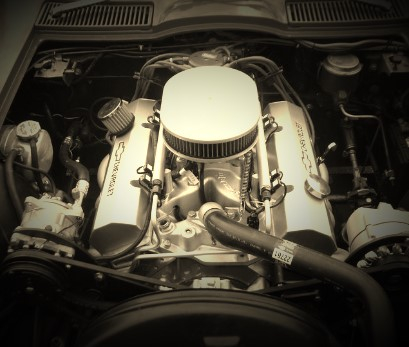Have you ever wondered what is the real efficiency of a drop of crude oil used (after refining) for automotive transport? Most of you already know that in general, efficiency is a measure of the effectiveness of energy conversion. For example, when the chemical potential energy contained by some amount of crude oil is converted to some always lesser amount of kinetic energy of vehicle motion, this fraction (kinetic energy output / chemical energy input) is the efficiency. It is natural to wonder about the numerical value of this efficiency. Let’s examine.
We begin by considering the energy conversion steps required to put an automobile into motion. We will limit our discussion to spark ignited gasoline engines since the majority of passenger vehicles burn gasoline, not diesel fuel. We will also neglect the “up to” 10% ethanol that is sometimes blended into gasoline mixtures since inclusion in our analysis would not significantly change the final observation.
Energy Conversion Steps to Vehicle Motion:
- Obtain oil – Rig construction, Worker transport, Drilling, Extraction
- Transport oil to refinery – Truck, Ship, Pipeline
- Refine oil – Produce a blend of hydrocarbons known as gasoline
- Transport gasoline to filling station – Tanker truck
- Convert chemical energy into thermal and pressure energy via engine combustion
- Convert thermal and pressure energy into automobile kinetic energy via pistons, gears, and wheels
Each of the above Steps 1 through 4 is associated with the use of energy from an external source (not the original arbitrary amount of oil). The energy requirement (or rate of use) and associated efficiency of these steps are not readily calculated as a portion of the total amount required to keep the vehicle in motion. The above Steps 5 and 6 are more easily quantified. Approximate average 4-stroke spark ignition engine thermal efficiency may be taken as 30% at typical part-load operation, meaning that 70% of the energy contained in the gasoline serves no useful purpose. Think about that. Before transferring power to the wheels, roughly 70% of the energy in the gasoline burned by a typical automobile engine is wasted and ultimately rejected to the environment (eventually outer space) as unrecoverable energy. Can you imagine throwing 70% of the food you buy into a trash bin?
Next, we have the loss associated with the vehicle drive train. A typical value is 7%. Thus, the 30% engine thermal efficiency is reduced to 28% (0.30 x 0.93 = 0.28). As already stated, the above Steps 1 through 4 are difficult to quantify, but it is easy to understand that the energy used in these steps must be charged as a loss to the arbitrary quantity of oil used in this example to induce automobile motion. It is reasonable to assume that Steps 1 through 4 correspond to a combined loss of at least, another 15%. Hence, we arrive at a maximum final efficiency of 24%. Various literature cites this value as typically 17 to 21%, which means that our example benefits the internal combustion engine in terms of efficiency comparison with other systems.
From the above, we can observe two important facts. First, and perhaps most notably, the great majority of the energy in oil used for transportation is lost, never to be available again. Second, despite the majority waste of energy, it is apparent that the energy density of oil is so substantial that its highly inefficient use has historically been of little worry. Only in recent years has it been more concerning, and then, only to the small portion of the population that considers how the energy available on the planet might be used more responsibly.
In contrast, the combined cycle power plant, which burns less refined (compared to gasoline) heavy oil or natural gas, is capable of 60% thermal efficiency. If electrical energy from the combined cycle plant were to be used to drive an electric automobile, then the associated efficiency losses and their typical values would be the following.
Electric Vehicle Efficiency Loss:
- Transmission line losses between plant and charging station (1%)
- Battery charging losses (15%)
- Motor and drive train losses (10%)
If we assume that the electric vehicle does not incorporate regenerative braking, then it is an easy matter to calculate the energy conversion efficiency (from power plant energy input to wheels in motion) as 45% (0.60 x 0.99 x 0.85 x 0.90 = 0.45), which is nearly double the final efficiency offered by the internal combustion engine powered vehicle.
So why aren’t all new cars manufactured as fully electric? First, battery technology has not yet reached the point of providing sufficiently long range driving capability. Secondly, it takes time for the cost of new technology to become affordable to the general public. It takes time also to adapt infrastructure and change the way business works. Lastly, the environmental impact of manufacturing an all electric car should be considered with concern especially for the batteries and electric motor, since these components represent the biggest departure from gasoline powered vehicle design. If battery and/or motor production relatively increases the negative environmental impact of automobile manufacturing, then a calculation should be made to determine how much more life (kilometers or miles) at the higher efficiency the electric vehicle must provide to offset the additional manufacturing caused burden placed upon the planet.
Some of you who know me personally are aware that I have had a passion for the rumble of the gasoline burning V8 engine since adolescence. Consequently, it may surprise you that I have authored this article. As a professional engineer dedicated, however, to scientific truth and responsible energy use, I would be remiss to reject the potential of the electric automobile in favor of the existing paradigm. I expect that with time, automotive transport will become increasingly electrified such that one day, gasoline burning vehicles will be the minority. Please note that the numeric values presented above are approximate but nevertheless, illustrative. It is my hope that they have given you something new and interesting to consider.

